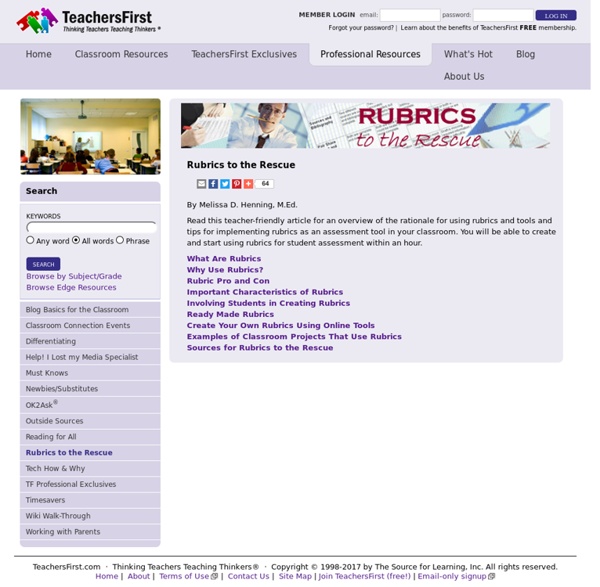



Assessment Assessment "Assessment is the process of collecting information on student achievement and performance. Assessment information provides the basis for sound decision making regarding teaching and learning." "The assessment process reveals what a student understands, knows and can do What is Assessment? Evaluation "Evaluation is a judgment regarding the quality, value or worth of a response, product, or performance, based on established criteria and curriculum standards" "The evaluation process indicates the quality of performance based on the curriculum (learner outcomes)." What is Evaluation? Reporting "According to McTighe, reporting documents should distinguish between the following factors: "... each of these factors should be reported separately. Source- A Framework for Communicating Student Learning, (AAC) 1999. p.21" Reporting How are assessment and evaluation related?
Understanding Rubrics by Heidi Goodrich Andrade Understanding Rubrics by Heidi Goodrich Andrade Authentic assessments tend to use rubrics to describe student achievement. At last, here’s clarity on the term. Every time I introduce rubrics to a group of teachers the reaction is the same — instant appeal (“Yes, this is what I need!”) followed closely by panic (“Good grief, how can I be expected to develop a rubric for everything?”). What Is a Rubric? A rubric is a scoring tool that lists the criteria for a piece of work, or “what counts” (for example, purpose, organization, details, voice, and mechanics are often what count in a piece of writing); it also articulates gradations of quality for each criterion, from excellent to poor. The four columns to the right of the criteria describe varying degrees of quality, from excellent to poor. Why Use Rubrics? Rubrics appeal to teachers and students for many reasons. Third, rubrics reduce the amount of time teachers spend evaluating student work. Finally, rubrics are easy to use and to explain.
How Do Rubrics Help? Rubrics are multidimensional sets of scoring guidelines that can be used to provide consistency in evaluating student work. They spell out scoring criteria so that multiple teachers, using the same rubric for a student's essay, for example, would arrive at the same score or grade. Rubrics are used from the initiation to the completion of a student project. They provide a measurement system for specific tasks and are tailored to each project, so as the projects become more complex, so do the rubrics. Rubrics are great for students: they let students know what is expected of them, and demystify grades by clearly stating, in age-appropriate vocabulary, the expectations for a project. Teacher Eeva Reeder says using scoring rubrics "demystifies grades and helps students see that the whole object of schoolwork is attainment and refinement of problem-solving and life skills." Rubrics also help teachers authentically monitor a student's learning process and develop and revise a lesson plan.
Technology Articles The teacher's role has changed in recent years. There has been a shift of emphasis from instructional techniques to developing learning techniques. Our role is no longer that of the "sage on the stage". Today our role leans more towards facilitator or "guide on the side". Our role is to increase student motivation and develop the skills or strategies that make a student more competent and to structure the learning environment so that students are able to take ownership of their own learning. Motivation and achievement have long been recognized to have a close cause-effect relationship, as of course have ability and achievement. Joanne Rand Whitmore's Giftedness, Conflict and Underachievement (1980) and Sylvia Rimm's Underachievement Syndrome (1986) both deal with this concept in some depth. My experiences as a teacher dealing with underachieving students from time to time have been greatly influenced by these two women. There are many strategies for motivating students. 1. 2. 3. 4. 5.
The Ten Commandments of Effective Classroom Management The Ten Commandments of Effective Classroom Management By William Shoap closeAuthor: William Shoap Name: William ShoapSite: See Authors Posts (1) William Shoap posted these commandments on the Classroom Management chatboard, and we thought them worthy of sharing here. One of the biggest barriers to teaching and learning in any school environment is the lack of effective classroom management methods. Young teachers, new to the teaching profession, may possess the necessary academic knowledge to teach their subject but often must learn classroom management skills on the job, which can make for a very challenging first few years in this career. Here are 10 practical tips for new teachers to aid in building a successful classroom management strategy: Thou shall be called by no other name than “Mr.” or “Mrs” or “Ms.” This entry was posted on Sunday, August 1st, 2010 and is filed under *ISSUES, August 2010, William Shoap.
Typing Test and Free Learn to Type Tutor Online s Study Skills Resources Create an online bulletin board (much like Padlet reviewed here or Lino reviewed here) for brainstorming and VOTING on any topic. The voting is what makes this tool different. Create an account. There is no waiting for email approval. tag(s): bulletin boards (17), gamification (53), images (258) In the Classroom Share your board with a projector or interactive whiteboard. Use Dotstorming to collect WebQuest links and information to share with students. Use Dotstorming as an "idea bin" where students can collect ideas, images, quotes, and more for a project. Worksheets, Lesson Plans, Teacher Resources, and Rubrics from TeAch-nology.com Scoring Rubric: Business Letter/Memo Printable (6th - 12th Grade) Hanukkah Celebrate the Festival of Lights in your classroom! Hanukkah begins at sundown December 6. December Calendar of Events December is full of events that you can incorporate into your standard curriculum. Hour of Code Introduce your students to basic coding and computer science! Videos Interested in using different types of media in your classroom? Teaching with Comics: Galactic Hot Dogs Reach reluctant readers and English-language learners with comics!